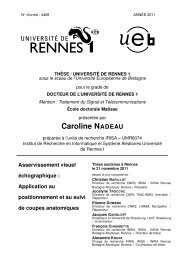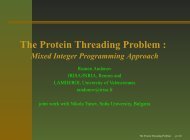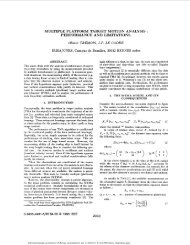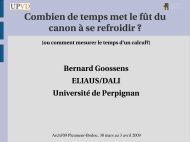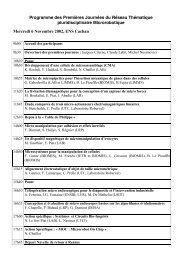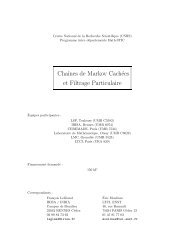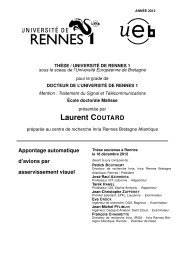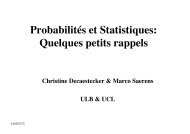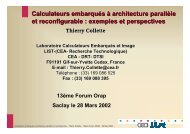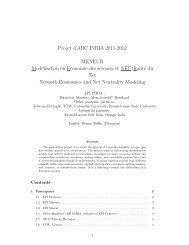Atelier Visualisation et extraction de connaissances - Irisa
Atelier Visualisation et extraction de connaissances - Irisa
Atelier Visualisation et extraction de connaissances - Irisa
Create successful ePaper yourself
Turn your PDF publications into a flip-book with our unique Google optimized e-Paper software.
C.Melo <strong>et</strong> M-A.Aufaure<br />
tion is based on the Action Message Format - AMF, a robust and one of the most efficient<br />
protocol for data exchange (www.jamesward.com/census/). D<strong>et</strong>ails of the implementation<br />
will be discussed in an upcoming publication.<br />
3 Visual Analytics with CUBIST Analytics<br />
The CUBIST project. 1 goal is to provi<strong>de</strong> Business Intelligence (BI) users with visualization<br />
and interaction techniques enhanced by semantic technologies and analysis m<strong>et</strong>hods such as<br />
Formal Concept Analysis (FCA). CUBIST analytics is key part of the project, focused on<br />
FCA for visual analytics. The visualization of the hierarchical relationship of concepts can be<br />
greatly enhanced beyond the standard approaches known from FCA and interlinked with best<br />
practices from known BI visualizations. The CUBIST analytics tool is currently being <strong>de</strong>veloped<br />
following a user-centered <strong>de</strong>sign paradigm in which targ<strong>et</strong> users are actively participating<br />
of the whole <strong>de</strong>velopment process, brainstorming sessions, prototype evaluations and<br />
interface refinements. The resulting technology will be <strong>de</strong>monstrated in three use cases from<br />
the domains of mark<strong>et</strong> intelligence, computational biology and space control centre operations.<br />
The problem of large lattices visualization is, to some extent, similar to the large graph<br />
visualization faced in graph analysis. There is an extensive literature in graph visualization<br />
and interaction and well known techniques which can provi<strong>de</strong> a valuable contribution to the<br />
lattice visualization (Herman <strong>et</strong> al. 2000). In the following sections we <strong>de</strong>scribe the visualization,<br />
navigation and interaction techniques employed in CUBIST analytics and discuss<br />
their advantages and limitations.<br />
Visualization. The first prototype of CUBIST analytics has four layouts for displaying the<br />
lattice structure: the traditional Hasse diagram, the in<strong>de</strong>nted tree, the sunburst (Stasko 2000)<br />
and a Force Directed with a Hasse diagram (repulsion forces b<strong>et</strong>ween edges). It is possible to<br />
zoom in and out the layout through the mouse scroll button. The sunburst layout position<br />
concept no<strong>de</strong>s in concentric circles similar to a radial tree with no<strong>de</strong>s adjusted to shape the<br />
concentric space (fig. 1). We used a modified version of the Prefuse Flare framework<br />
(flare.prefuse.org) for Flex to handle the events, structure and animations un<strong>de</strong>rneath.<br />
Navigation. The full topology of a lattice seems to be little help in the analytical process<br />
(Carpin<strong>et</strong>o & Romano 1995; Priss 2006). The display of the traditional Hasse diagram is<br />
only partial for large lattices and we have opted for a combination b<strong>et</strong>ween keyboard and<br />
mouse for a faster and gestural navigation. The user holds the “shift” key to gain an interactive<br />
control for scrolling through layout's anchor point in response to the mouse movement<br />
(fig. 2). Optionally it is possible to enable the Fish Eye (Sarkar & Brown 1992) distortion - it<br />
makes the concept no<strong>de</strong> appear bigger when the mouse pointer is over and display its subsequent<br />
relatives in a <strong>de</strong>creasing scale size. This technique is well known in graph navigation<br />
literature, known as focus+context distortion (Kreuseler & Schumann 1999). It allows the<br />
user to focus on items he or she selects without losing the context around (e.g. the concept<br />
hierarchy).<br />
1<br />
“Combining and Uniting Business Intelligence with Semantic Technologies”. Visit www.cubistproject.eu<br />
for more information.<br />
F.Poul<strong>et</strong>, B.Le Grand : 9e <strong>Atelier</strong> <strong>Visualisation</strong> <strong>et</strong> Extraction <strong>de</strong> Connaissances 51



